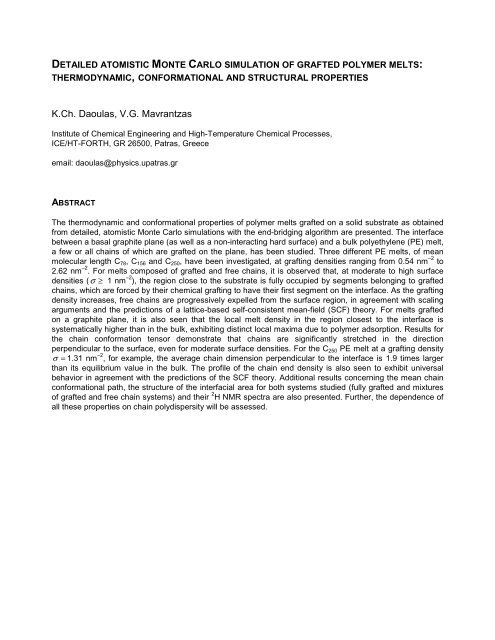Collapse of polymer brushes grafted onto planar ... - Wageningen UR
Collapse of polymer brushes grafted onto planar ... - Wageningen UR
Collapse of polymer brushes grafted onto planar ... - Wageningen UR
Create successful ePaper yourself
Turn your PDF publications into a flip-book with our unique Google optimized e-Paper software.
DETAILED ATOMISTIC MONTE CARLO SIMULATION OF GRAFTED POLYMER MELTS:<br />
THERMODYNAMIC, CONFORMATIONAL AND STRUCT<strong>UR</strong>AL PROPERTIES<br />
K.Ch. Daoulas, V.G. Mavrantzas<br />
Institute <strong>of</strong> Chemical Engineering and High-Temperature Chemical Processes,<br />
ICE/HT-FORTH, GR 26500, Patras, Greece<br />
email: daoulas@physics.upatras.gr<br />
ABSTRACT<br />
The thermodynamic and conformational properties <strong>of</strong> <strong>polymer</strong> melts <strong>grafted</strong> on a solid substrate as obtained<br />
from detailed, atomistic Monte Carlo simulations with the end-bridging algorithm are presented. The interface<br />
between a basal graphite plane (as well as a non-interacting hard surface) and a bulk polyethylene (PE) melt,<br />
a few or all chains <strong>of</strong> which are <strong>grafted</strong> on the plane, has been studied. Three different PE melts, <strong>of</strong> mean<br />
molecular length C78, C156 and C250, have been investigated, at grafting densities ranging from 0.54 nm –2 to<br />
2.62 nm –2 . For melts composed <strong>of</strong> <strong>grafted</strong> and free chains, it is observed that, at moderate to high surface<br />
densities (σ ≥ 1 nm –2 ), the region close to the substrate is fully occupied by segments belonging to <strong>grafted</strong><br />
chains, which are forced by their chemical grafting to have their first segment on the interface. As the grafting<br />
density increases, free chains are progressively expelled from the surface region, in agreement with scaling<br />
arguments and the predictions <strong>of</strong> a lattice-based self-consistent mean-field (SCF) theory. For melts <strong>grafted</strong><br />
on a graphite plane, it is also seen that the local melt density in the region closest to the interface is<br />
systematically higher than in the bulk, exhibiting distinct local maxima due to <strong>polymer</strong> adsorption. Results for<br />
the chain conformation tensor demonstrate that chains are significantly stretched in the direction<br />
perpendicular to the surface, even for moderate surface densities. For the C250 PE melt at a grafting density<br />
σ = 1.31 nm –2 , for example, the average chain dimension perpendicular to the interface is 1.9 times larger<br />
than its equilibrium value in the bulk. The pr<strong>of</strong>ile <strong>of</strong> the chain end density is also seen to exhibit universal<br />
behavior in agreement with the predictions <strong>of</strong> the SCF theory. Additional results concerning the mean chain<br />
conformational path, the structure <strong>of</strong> the interfacial area for both systems studied (fully <strong>grafted</strong> and mixtures<br />
<strong>of</strong> <strong>grafted</strong> and free chain systems) and their 2 H NMR spectra are also presented. Further, the dependence <strong>of</strong><br />
all these properties on chain polydispersity will be assessed.

















